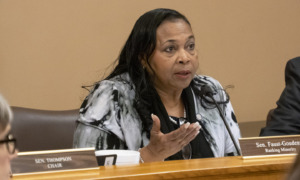 Twenty years ago, when the foster care system in Illinois was at its worst, with 50,000 children trapped in foster care, an advocate in that state said the system had become “like a laboratory experiment to produce the sexual abuse of children.”
Twenty years ago, when the foster care system in Illinois was at its worst, with 50,000 children trapped in foster care, an advocate in that state said the system had become “like a laboratory experiment to produce the sexual abuse of children.”
Now, with about 17,000 children in foster care, independent monitors say the Illinois system is much improved, though much remains to be done.
But the laboratory didn’t close — it just moved south. A court decision released last December is a guided tour through the hellscape that is foster care in Texas. It chronicles abuse in foster care that isn’t just common, it’s rampant. And it documents how the state turned a blind eye to suffering on a massive scale.
The decision was issued by U.S. District Court Judge Janis Graham Jack. She ruled in favor of plaintiffs in a class-action suit brought originally by the group that calls itself Children’s Rights. When that group and its founder, Marcia Lowry, divorced and Lowry formed a new group, A Better Childhood, each got custody of some of the lawsuits. Lowry got the Texas case.
The decision should be required reading for all who cling to the lie that foster care is a safe haven and there is, as one prominent denier claimed, “very little” abuse there (in spite of all the studies that show otherwise). It should be read by anyone who takes seriously the ridiculously low numbers states report to the federal government when they are asked about abuse in foster care. But Marcia Lowry and the other lawyers who worked on the case also need to read it again.
Because while a court order like this one is certainly better than no court order, and the lawsuit was better than no lawsuit, I do not understand how anyone can read that decision, let alone live with the case for years, and not conclude that a part of the solution is finding ways to keep more children out of this foster care horror show in the first place.
Yet, as is typical with her litigation, Marcia Lowry asked for no remedies to reduce needless foster care, and the decision contains none. There is no effort to curb needless removal even though most cases are nothing like the horror stories that make headlines. Far more common are cases in which family poverty is confused with “neglect.”
What is so shocking about what Judge Jack found is the pervasiveness of the abuse. She writes:
- “The evidence reveals that child-on-child physical and sexual abuse is typical, common, and widespread throughout Texas foster care. … [The children] have been shuttled through a system where rape, abuse, psychotropic medication and instability are the norm.”
- “The already staggering number of [known] abuse and neglect incidents … is likely much higher because foster children either do not know who to contact, do not feel that anything will be done, or fear retaliation.”
- “[There] appears to be a set pattern of [Department of Family and Protective Services] investigations of abuse in care. First, DFPS refuses to document or recognize child-on-child abuse. Second, even when a child is abused in foster care, the standards for finding that abuse occurred are impossibly difficult. It appears that, unless witnessed by an adult who admits seeing the abuse and thereafter refuses to do anything about it, the [standard to substantiate abuse] cannot be met. … This Dickensian approach to child abuse keeps the confirmed reports of abuse in care findings artificially low.”
- In the past five years, Texas regulators closed only one group home or institution — but only after “the fourth homicide” there.
- DFPS uses “make believe people” to make caseloads look artificially low. And because regular caseworkers are so overloaded they don’t have time to see the children very often, Texas created a new category of substitutes called “I see you” workers to perform what amount to drive-by visits. The judge implies that the whole process is a sham to make Texas look like it’s in compliance with minimal requirements to keep federal aid dollars flowing in.
Compared to all this horror, many of the remedies ordered by the judge are puny — such as insisting that there be at least one staffer awake at night in group homes.
CR likes to claim it’s impossible to sue over children not yet in foster care — though they’ve done it at least once. But there is no doubt they can be included in a settlement. And a settlement can be built around safe, proven programs to keep families together. That’s what happened in Alabama. (An board member of the National Coalition for Child Protection Reform was counsel for plaintiffs in that suit.)
It could be done all over the country — if only CR and A Better Childhood, which combined are the 800-pound gorilla of child welfare litigation — had the will to do it.
Richard Wexler is executive director of the National Coalition for Child Protection Reform.
































